Posted by: Northwest Eye in General on June 18, 2025
Overview
Bifocal contact lenses are thoughtfully designed to provide clear vision at varying distances, making them an effective solution for managing presbyopia. This innovation enhances daily life by eliminating the need for multiple pairs of glasses. We understand that the prospect of adjusting to new lenses can be daunting. However, the benefits of bifocal contacts include improved clarity for both near and distant vision, which can significantly enhance your quality of life.
It’s common to feel some discomfort during the adjustment period, and it’s important to address these feelings. Consulting with eye care professionals is crucial for achieving optimal fitting and comfort. They can guide you through the process, ensuring that your experience is as smooth as possible. Remember, you are not alone in this journey; we are here to help you through this process.
Introduction
Bifocal contact lenses are transforming how individuals manage their vision, especially for those facing presbyopia—a common age-related condition. We understand that navigating changes in vision can be challenging. These innovative lenses provide the convenience of clear sight at various distances, eliminating the need for frequent eyewear changes. This can significantly enhance your daily activities and overall comfort.
However, as you contemplate this transition, it’s common to have questions about the adjustment period, possible drawbacks, and the best options available. We are here to help you through this process and provide insights that can guide you toward improved vision and comfort.
Northwest Eye: Expert Care for Bifocal Contact Lens Fitting
At Northwest Eye, we understand that adjusting to can be a significant change for our patients. With over 50 years of expertise in eye care, we are here to provide . Our clinic utilizes to ensure that you receive the best possible solutions.
We know that . Our ophthalmic surgeons prioritize your understanding, ensuring you are well-informed about how to achieve with bifocal contacts. This personalized approach not only enhances your fitting experience but also contributes to .
Many of our patients share positive experiences, highlighting our commitment to . Recent advancements in further enhance the fitting process, allowing for .
At Northwest Eye, we emphasize the critical role of . We are dedicated to meeting each patient’s unique needs with precision and expertise, guiding you every step of the way. Remember, we are here to help you through this process, ensuring you feel supported and informed.
Understanding Bifocal Contact Lenses: Definition and Functionality
is thoughtfully designed to provide you with at different distances, typically featuring within a single pair of glasses. The upper section is tailored for , while the lower part is perfect for , like reading your favorite book. This dual functionality allows you to move effortlessly between various visual activities without the hassle of switching glasses.
We understand that adapting to bifocals can feel overwhelming at first. However, many wearers find that this convenient solution makes much easier. Imagine being able to enjoy your favorite activities without interruption!
If you have any concerns or questions about bifocal eyewear, remember that we are here to help you through this process. Your comfort and clarity are our top priorities.
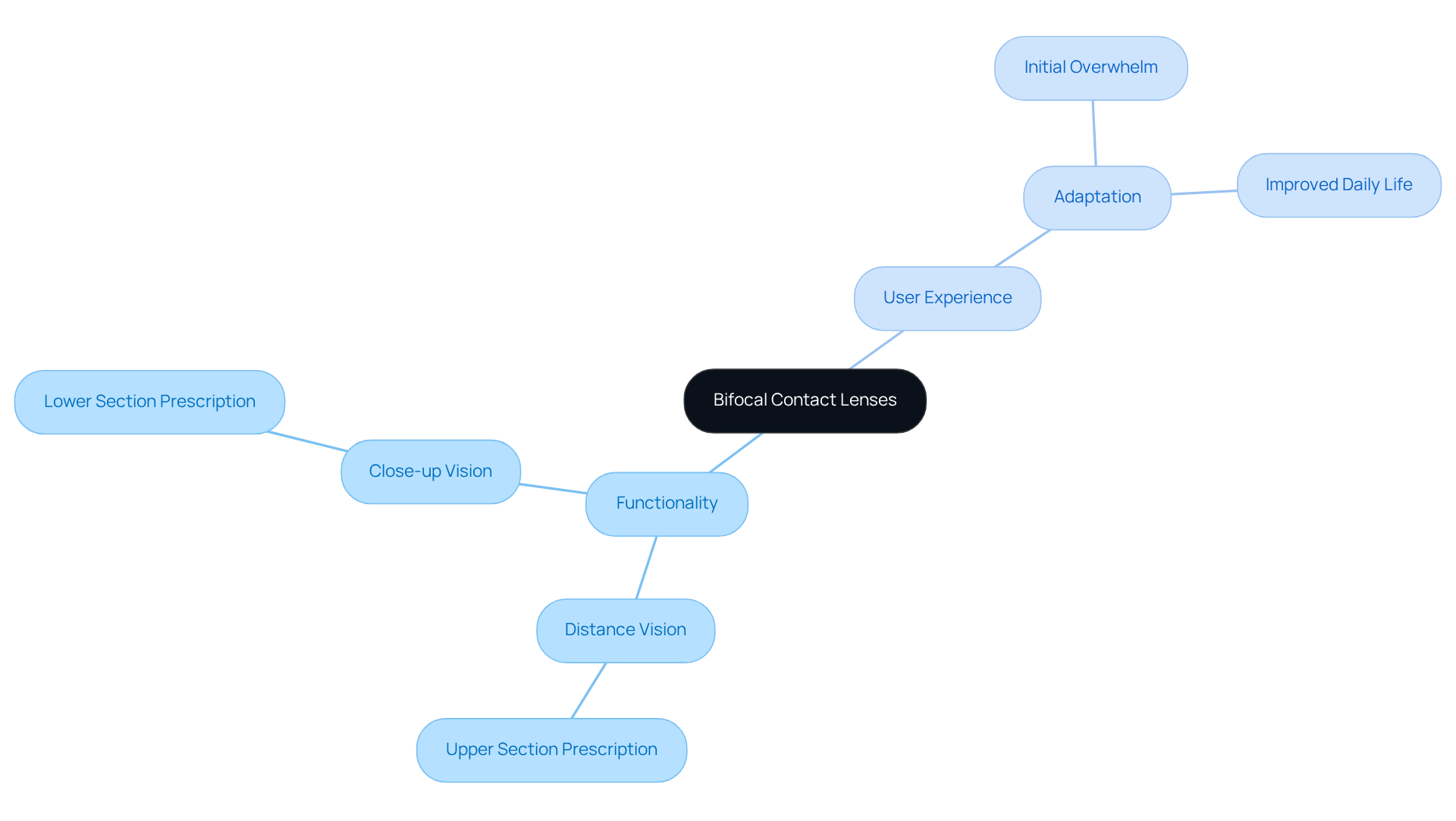
Benefits of Bifocal Contact Lenses: Enhanced Vision and Convenience
provide considerable benefits, especially for those experiencing . They improve clarity for both near and distant objects, which can eliminate the need for , providing unparalleled convenience and comfort. We understand that this transition can feel daunting, but many users report . They can without the hassle of switching between different eyewear.
For instance, Mary Ellen Williams expressed her satisfaction, stating, “My vision now after having the ClearView 3 is perfect. It’s as close to perfect as it’s going to get.” Such testimonials highlight the , allowing individuals to embrace a more active and fulfilling lifestyle. Moreover, the creative structure of these optics caters to the visual requirements of users, making them a favored option for effectively managing presbyopia.
However, it’s common to feel uncertain about making this change. Therefore, it is crucial to seek advice from an before transitioning to bifocal contacts or other multifocal eyewear. This ensures an . Additionally, prospective users should be aware that can cost as much as $1,500 annually without insurance. The adaptation phase may include some discomfort and eye fatigue at first, but remember, we are here to help you through this process.
Drawbacks of Bifocal Contact Lenses: Considerations Before Use
offer several benefits, but we understand that they also come with significant downsides that you should consider. One notable challenge is the ; many users report experiencing , visual disturbances, eye strain, or headaches as they adapt to the . It’s common to feel this way, and the duration of this adjustment phase can vary. Some individuals find it easier to acclimate than others, and that’s perfectly okay.
Studies show that while success rates for bifocal contacts range from 67 to 83 percent among users, not everyone is a suitable candidate. If you have , such as or notable astigmatism, you may find these products ineffective. Additionally, distorted eyesight can indicate underlying eye issues, like , which may affect the suitability of dual-vision glasses. Therefore, it’s with your to evaluate your specific visual requirements and determine if bifocal contacts are the right choice for you.
As one eye care specialist observes, “Comprehending your daily routines and is crucial in making an informed choice regarding eyewear options.” Moreover, it’s important to acknowledge that there are two kinds of bifocal lenses:
- Segmented, which have separate upper and lower parts
- Concentric, which feature an outer ring for one refractive error and an inner ring for another
We are here to help you through this process and ensure you find the best solution for your vision.
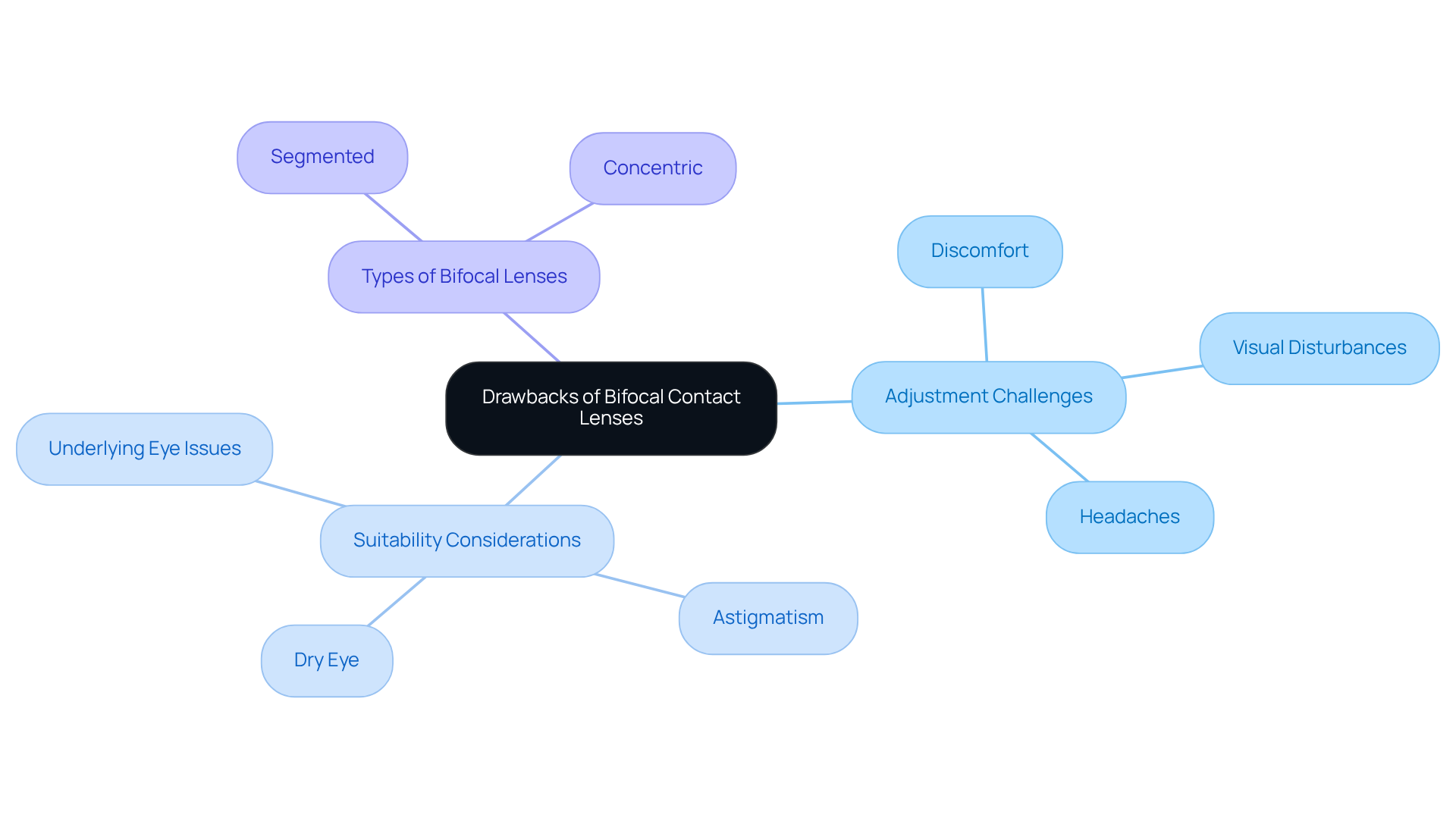
Bifocal Contacts for Presbyopia Management: Targeting Age-Related Vision Changes
serve as a compassionate remedy for addressing , a common . As we age, the lens of our eyes loses flexibility, making it harder to focus on nearby objects. Bifocal lenses rise to this challenge, enabling users to see clearly at both close and distant ranges. This greatly enhances their quality of life and reduces the need for reading glasses.
We understand that changes in vision can be concerning. According to specialists, the effectiveness of dual-focus lenses in managing is well-documented. For instance, John Dreyer, an optometrist, highlights that presbyopia impacts a , with around 1.8 billion individuals affected as of 2025—about 25% of the world’s population. This statistic underscores the importance of available , such as multifocal eyewear.
Demographic factors also influence the prevalence of presbyopia, with women more likely to develop this condition than men. Recognizing this is crucial for understanding the target audience, especially as the number of individuals affected continues to rise.
Real-life stories demonstrate the transformative effects of bifocal contacts. Many older adults share experiences of improved daily functioning and increased confidence in activities like reading, sewing, or using digital devices. Bifocal contacts not only provide clarity but also support a more dynamic lifestyle, allowing individuals to engage in their passions without the hassle of switching between different pairs of glasses.
The is significant, leading to a global productivity loss estimated at around US$ 411 billion annually. As the prevalence of presbyopia continues to increase, projections suggest that by 2030, the number of affected individuals could rise to 2.1 billion. This growth emphasizes the need for effective eye correction solutions. Bifocal eyewear represents a modern approach to addressing age-related vision changes, offering a convenient and user-friendly alternative to traditional reading glasses.
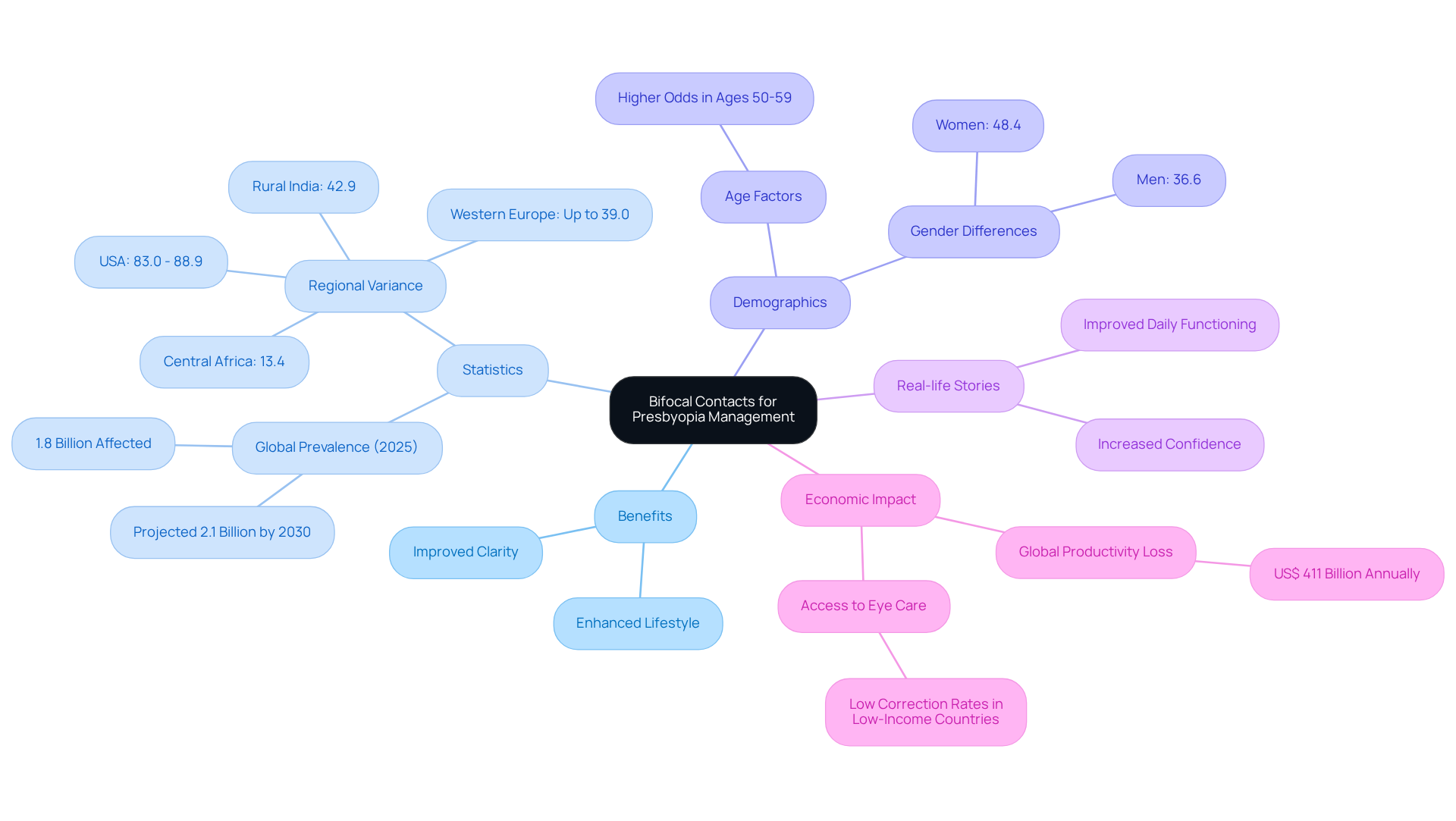
Cost of Bifocal Contact Lenses: What to Expect
We understand that the price of dual-focus eyewear can fluctuate significantly based on factors such as brand, type, and whether they are daily or monthly disposables. Typically, patients can expect to spend between $200 and $500 annually for . It’s common to feel concerned about additional costs, such as and follow-up appointments, which may also impact the overall expense.
may cover part of these costs, so we encourage you to . Ensuring that is in-network and that your plan covers the services provided can help ease your . Additionally, it’s important to be aware that obtaining may be necessary depending on your insurance plan. Confirming these details before scheduling your appointments can make the process smoother and less stressful.
We are here to help you through this process, ensuring you receive the care you need without added anxiety.
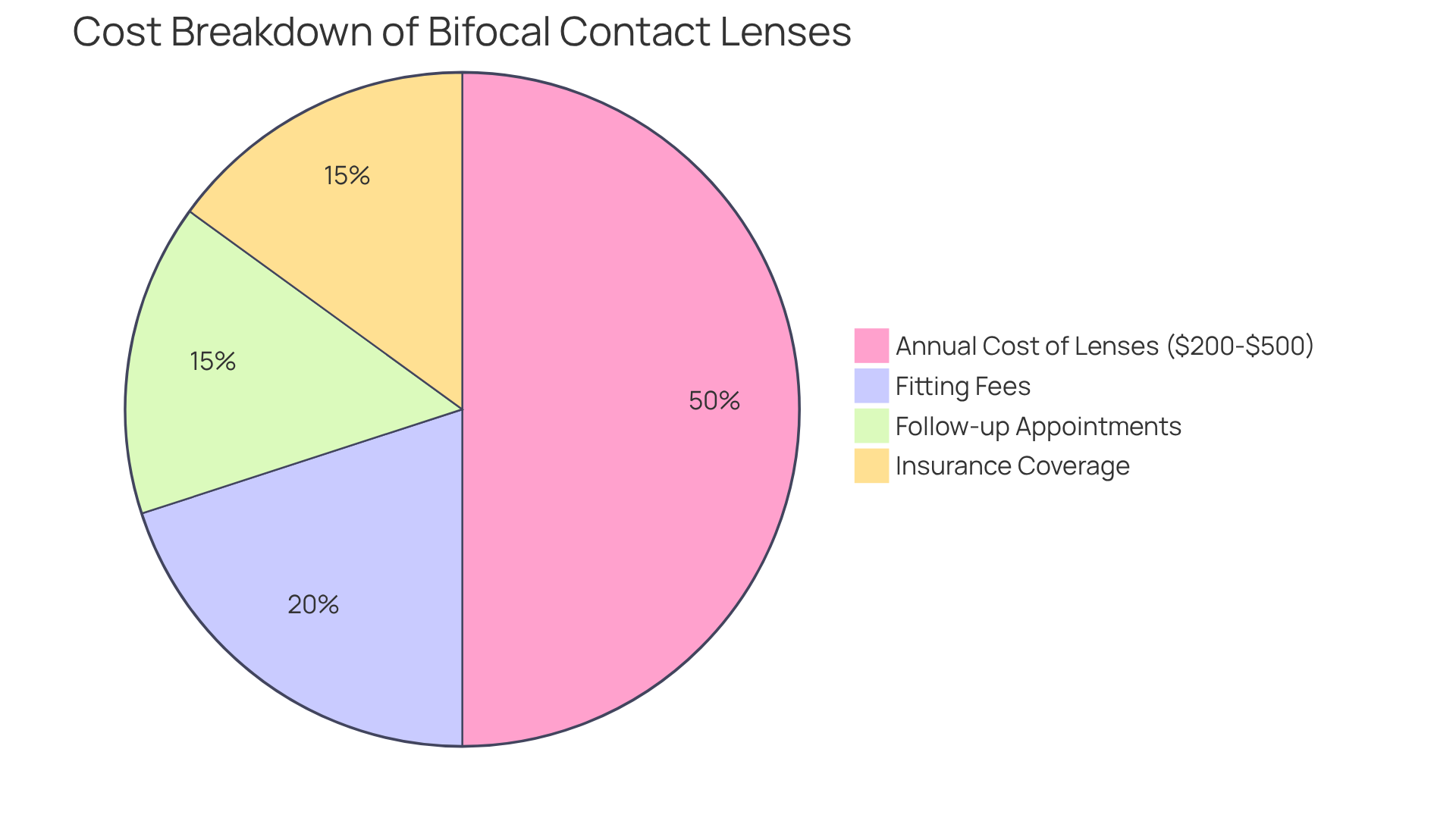
Top Brands of Bifocal Contact Lenses: Quality Choices for Clear Vision
A variety of reputable brands offers high-quality products, including Acuvue, Biofinity, and Air Optix. We understand that can feel overwhelming. Acuvue is recognized for its comfort and excellent vision quality, while Biofinity stands out for its moisture retention and breathability. Air Optix products are crafted to retain moisture and ensure a secure fit, making them perfect for individuals with astigmatism.
It’s common to feel concerned about your vision needs. Significantly, around 45 million individuals in the United States use , highlighting the necessity of selecting the appropriate options. Bifocal spectacles can cost up to $1,500 each year without insurance, which can be a significant burden. That’s why it’s crucial for patients to consult with their to determine the brand and type that best suit their lifestyle and vision needs.
As one optometrist puts it, “Confidence is seeing clearly in every step you take.” This tailored method guarantees maximum comfort and clarity, enhancing the overall experience of wearing bifocal contacts. We are here to help you through this process, ensuring you every step of the way.
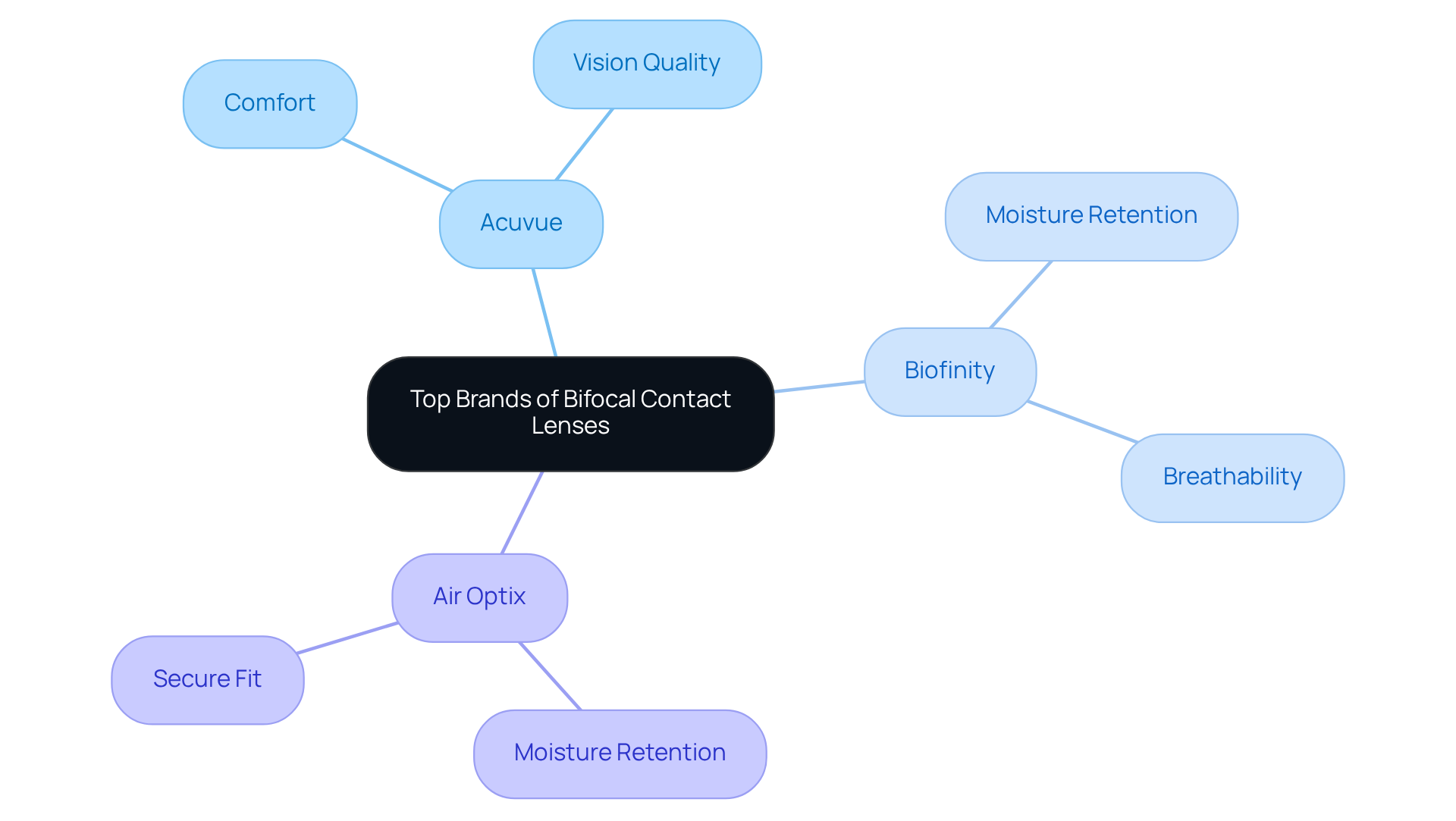
Bifocal Contact Lenses FAQ: Common Questions Answered
It’s completely normal for new users of to have questions. One of the most common concerns is the . Typically, it takes about one to two weeks for your eyes to fully acclimate to these new lenses. This time allows your eyes to adjust to the two prescriptions integrated into your eyewear.
Another frequent question is whether bifocal contacts are appropriate for those with . The answer is yes! These bifocal contacts are designed to accommodate various activities, including exercise, without compromising your vision quality.
We understand that . If you experience ongoing discomfort, it’s important to reach out to your . They can make necessary adjustments to enhance your comfort and fit. Eye care specialists emphasize that choosing the right design for your bifocal contacts can significantly impact your overall experience. As Nancy Del Pizzo wisely notes, “You may need to experiment with various before discovering the one that suits you best.” is often part of the fitting process, ensuring you find the optimal match for your personal needs, which is crucial for a successful adjustment.
Additionally, it’s important to know that can be prescribed for individuals with astigmatism, and . Understanding these factors can help you with dual-focus eyewear more effectively. Remember, we are here to help you through this process.
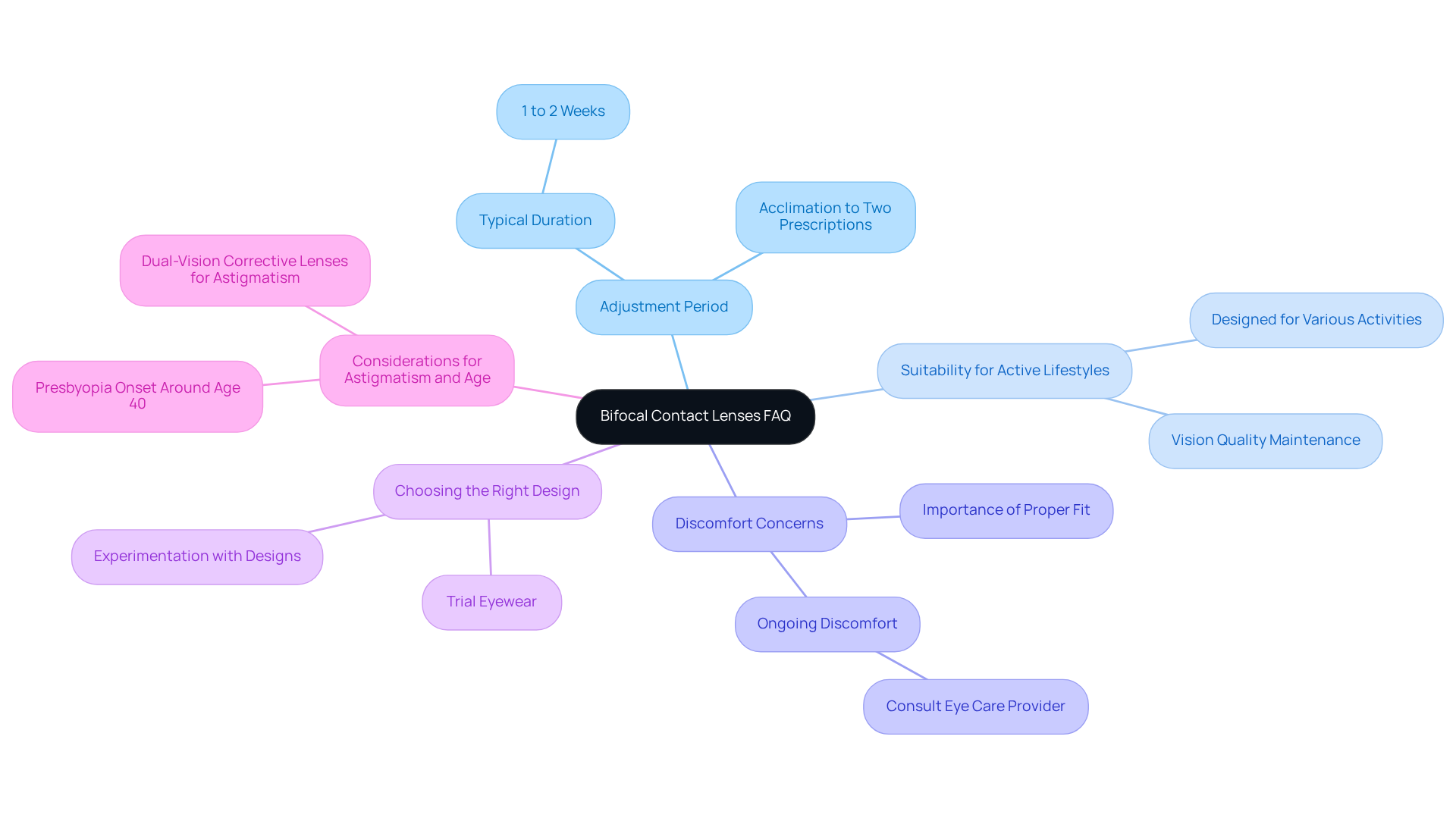
Consulting Eye Care Professionals: The Key to Successful Bifocal Contact Use
Seeking advice from is crucial for anyone considering dual-vision eyewear. We understand that this decision can feel overwhelming, and these specialists provide that take your personal eyesight needs into account. This ensures you choose the most appropriate optical options for your unique situation.
Correct fitting is essential, as two prescriptions within a single lens, which differs significantly from standard contacts. It’s common to feel uncertain about how these will work for you, but are vital. They help monitor any changes in your vision and allow for necessary adjustments, enhancing both comfort and effectiveness.
Research shows that individuals who interact with eye care specialists achieve greater success rates in dual-vision fittings. These experts can address potential issues like and , especially for those who spend a lot of time on computers. However, it’s important to note that you may experience an adjustment period when transitioning to . Some users report feeling eye strain, particularly with segmented versions used for reading and extensive computer work.
You might also want to consider options beyond dual-focus lenses, such as multifocal or monovision lenses. Hearing from other satisfied patients highlights the importance of in achieving ideal sight correction with . We are here to help you through this process, ensuring you feel supported every step of the way.
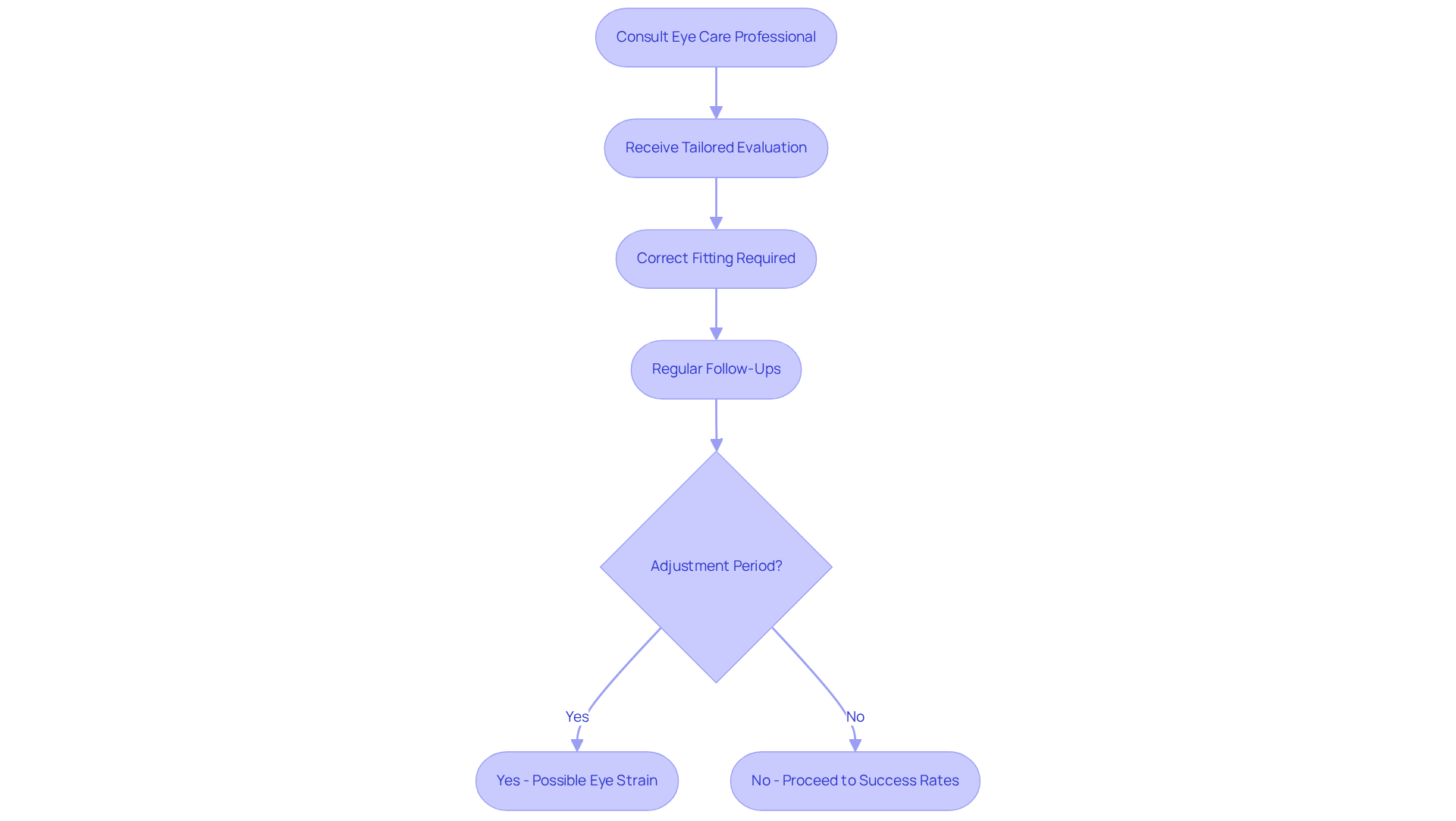
Exploring Bifocal Contact Lenses: A Viable Solution for Vision Needs
Bifocal lenses offer a compassionate solution for those experiencing and other . We understand that clear sight at various distances is essential for enhancing your daily activities and improving your overall quality of life. With the help of skilled eye care specialists, you can find the right tailored to your unique needs, ensuring you enjoy the benefits of improved vision without the hassle of juggling multiple pairs of glasses.
Statistics reveal that the success rate for dual-vision eyewear ranges from 67% to 83%, showcasing their effectiveness. Additionally, the is valued at over $1 billion and is growing at a double-digit rate, reflecting the increasing demand for these .
It’s common to feel a bit apprehensive about adapting to , as users may experience an . Some might also encounter visual symptoms like glare or halos. However, it’s important to remember that bifocal lenses have been thoughtfully developed to meet the needs of aging baby boomers, providing a convenient option for those who prefer not to rely on reading glasses. We are here to help you through this process, ensuring you feel supported every step of the way.
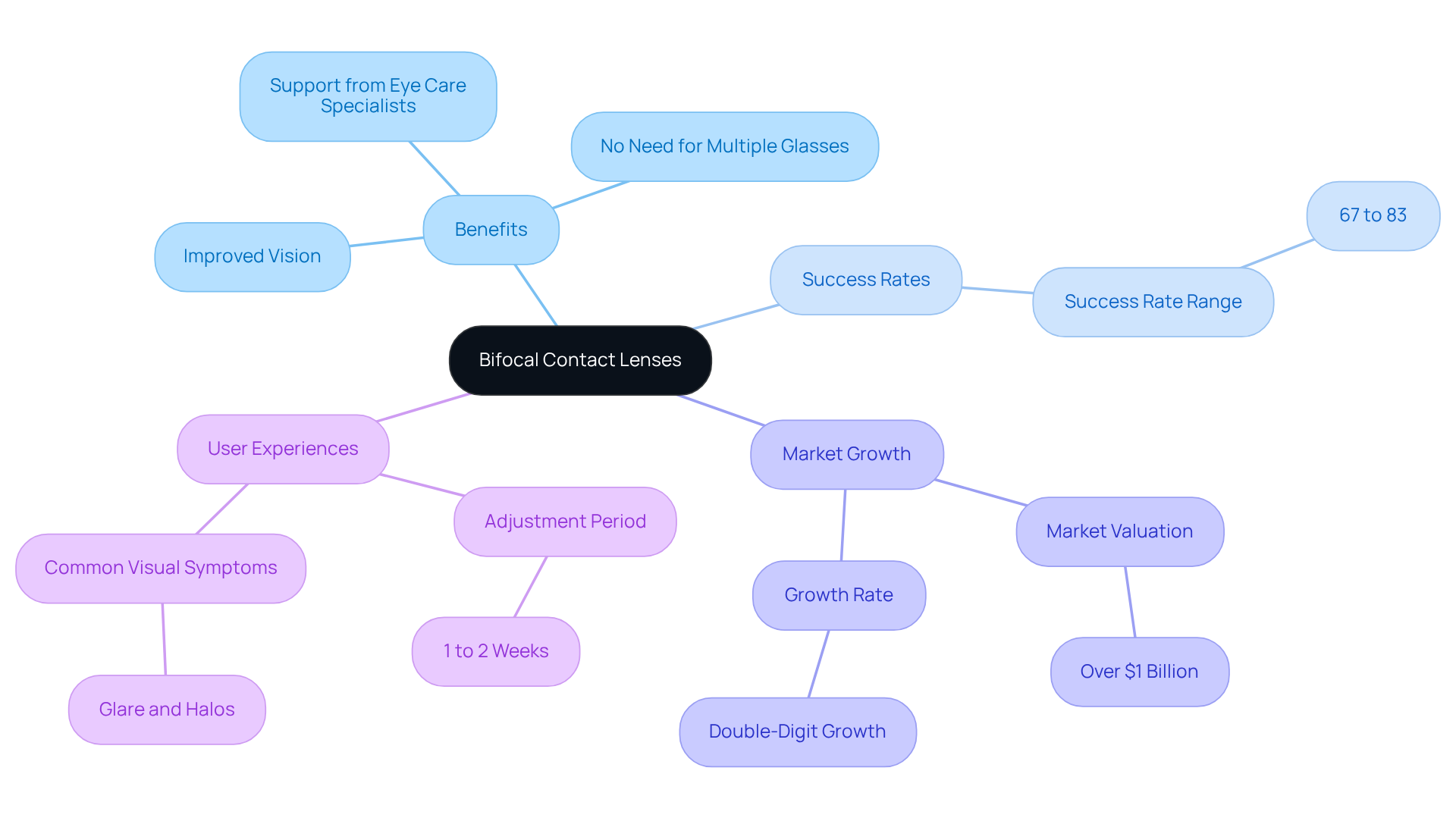
Conclusion
Bifocal contact lenses represent a significant advancement in vision correction, particularly for those dealing with presbyopia and age-related vision changes. We understand how challenging it can be to manage vision changes as you age. By integrating two prescriptions into a single lens, these contacts enable users to experience clear vision at varying distances without the inconvenience of switching glasses. This innovative solution not only enhances daily activities but also promotes a more active and fulfilling lifestyle.
Throughout our discussion, we have highlighted key insights, including the benefits of improved clarity and convenience. It’s important to consult eye care professionals for personalized fitting, as they can help you navigate this transition smoothly. We also recognize that there may be potential challenges during the adjustment period, and understanding the cost implications while exploring reputable brands can empower you to make informed decisions about your vision care. The positive testimonials from satisfied patients underscore the transformative impact of bifocal contacts on quality of life, reminding us that you are not alone in this journey.
As the demand for effective vision correction solutions continues to grow, embracing bifocal contact lenses can be a proactive step toward maintaining optimal sight. We encourage you to consult with eye care specialists to find the right lenses tailored to your unique needs. By doing so, you can enhance your visual experience and enjoy the freedom that comes with clear sight at all distances. Remember, we are here to help you through this process and support you in achieving the best possible vision.
Frequently Asked Questions
What is the purpose of bifocal contact lenses?
Bifocal contact lenses are designed to provide clear vision at different distances, with the upper section for seeing far away and the lower part for close-up tasks, allowing users to transition between various visual activities without needing to switch glasses.
What are the benefits of using bifocal contact lenses?
Bifocal contacts improve clarity for both near and distant objects, eliminate the need for multiple pairs of glasses, and enhance convenience and comfort for activities like reading, driving, and using digital devices.
How does Northwest Eye support patients during the bifocal contact lens fitting process?
Northwest Eye offers personalized care, advanced techniques, and cutting-edge technology, ensuring that patients are well-informed and supported throughout the fitting process to achieve optimal sight correction.
What should I expect during the adaptation phase of using bifocal contact lenses?
During the adaptation phase, some users may experience discomfort and eye fatigue initially. However, many find that the benefits of improved vision and convenience outweigh these challenges.
How much can bifocal contact lenses cost annually?
Bifocal contact lenses can cost as much as $1,500 annually without insurance.
What do patients say about their experience with bifocal contact lenses at Northwest Eye?
Many patients report positive experiences, highlighting the compassionate care and effective treatment outcomes they receive, with testimonials reflecting significant improvements in their quality of life.
Is it necessary to consult an eye care expert before transitioning to bifocal contact lenses?
Yes, it is crucial to seek advice from an eye care expert before making the transition to ensure an optimal fit and comfort tailored to your specific needs.






